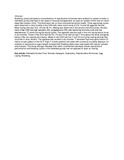| dc.contributor.author | Kimata, DM | |
| dc.contributor.author | Mwangi, RW | |
| dc.contributor.author | Mathiu, P | |
| dc.date.accessioned | 2013-07-17T06:09:21Z | |
| dc.date.available | 2013-07-17T06:09:21Z | |
| dc.date.issued | 2010 | |
| dc.identifier.citation | Kimata, MD, Mwangi RW, Mathiu P. 2010. Adverse Effects of Indoor Confinement on Reproductive Performance and Hormone Levels in the Helmeted Guinea Fowl Numida meleagris. Seventh Biennial Scientific Conference CAVS, UON Sept 8 - 10 . :25., CAVS, UoN | en |
| dc.identifier.uri | http://profiles.uonbi.ac.ke/kimata/publications/adverse-effects-indoor-confinement-reproductive-performance-and-hormone-levels-h | |
| dc.identifier.uri | http://hdl.handle.net/11295/48211 | |
| dc.description.abstract | Breeding cycles and plasma concentrations of reproductive hormones were studied for sixteen months in helmeted guinea fowl kept in two types of housing management; an open-air system (OAS) and an indoor deep litter system (DLS). The birds were fed on local conventional poultry feeds. Three egg laying cycles were observed in rainy months in the OAS with mean clutch sizes of 2.6, 14 and 26 eggs per female. Mean laying rate was 16.2, 24 and 36.1%. Mating was observed in the second and third cycles. Guinea hens in the OAS had high estradiol (E2), progesterone (P4) and luteinizing hormone (LH) and low testosterone (T) levels during the laying cycles. The opposite was the case in the non-laying status found in dry months. Those in the DLS had low E2, P4 and LH as well as high T throughout the study alongside being in the non-reproductive status. Males in the OAS had low T and LH during the mating periods that occurred in rainy months. The opposite was evident in dry months. T remained high throughout while LH had an erratic pattern in the DLS. High T in both systems coincided with numerous courtship displays. An analysis of reproductive organ weight revealed that breeding status was associated with heavier gonads and oviducts. This study strongly indicates that indoor confinement adversely affects reproductive performance and breeding cycles in the helmeted guinea fowl as opposed to open air rearing.
Key words: Helmeted Guinea Fowl, Numida meleagris, Husbandry, Reproductive Hormones, Egg Laying, Breeding. | |
| dc.language.iso | en | en |
| dc.title | Adverse Effects of Indoor Confinement on Reproductive Performance and Hormone Levels in the Helmeted Guinea Fowl Numida meleagris | en |
| dc.type | Article | en |
| local.publisher | College of Biological and Physical Sciences, University of Nairobi | en |

